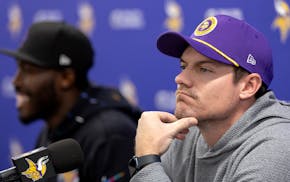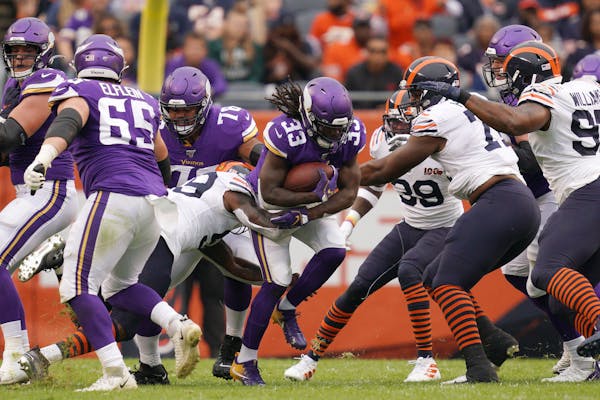Welcome to our morning-after Vikings blog, where we'll revisit every game by looking at three players who stood out, three concerns for the team, three trends to watch and one big question. Here we go:
The Vikings came into Sunday's game against the Bears vowing to run the ball, even as they faced a run front that ranked as one of the best in a generation last year.
Even without Akiem Hicks and Roquan Smith on Sunday, the Bears controlled Cook to the point the Vikings weren't rewarded for their reliance on the run game for the first time this year. He gained only 35 yards on 14 carries, running into a Bears scheme that seemed primed to slow him down on Sunday.
According to NFL Next Gen Stats, the Bears put eight or more defenders in the box on five of Cook's 14 carries on Sunday, forcing him to face heavy fronts more frequently than all but six running backs in the league during Week 4.
His longest gain of the day was a nine-yarder in the fourth quarter that came out of a three-receiver set with the Vikings trailing 16-0. Other than that, Cook found himself searching for room, rather than being able to make a decisive burst through the line. According to Next Gen Stats, Cook was behind the line of scrimmage for an average of 3.01 seconds on Sunday, longer than he's needed to hit a hole the entire season. Per Pro Football Focus, 21 of Cook's 35 yards came after contact.
"Very difficult, especially when you're trying to make plays and get a first down, just get something going," Cook said of the lack of running room. "But Chicago did a great job of doing what they do."
By my count, Cook ran behind a fullback or an extra tight end on 10 of his 14 carries on Sunday. That's part and parcel to the Vikings' offense this season, and it's helped open holes for Cook so far this year. It could, however, invite more defenders into the box, rather than forcing them to defend the run from a wider angle, especially as teams scheme to stop Cook and force the Vikings to throw the ball. The Vikings won't face many run fronts as talented as the Bears' group (though the Eagles could present a challenge in two weeks), but they're likely to see teams gearing up for Cook until they make opponents pay for it.
Here are two other areas of concern following the Vikings' 16-6 loss:
Passing game production: The fact Kirk Cousins was sacked six times on Sunday — including two that forced fumbles — is a well-established part of the Vikings' problems on Sunday. But the Vikings' issues extended further than that, as the Bears forced Cousins to escape the pocket or check the ball down without options developing downfield. According to Next Gen Stats, Cousins held the ball for an average of 3.05 seconds before throwing on Sunday — a game in which his average completion traveled just 4.02 yards. The Bears were able to take away some of Cousins' downfield looks with coverage, and their pass rush forced him to speed up his timetable on other occasions. But Cousins missed what could have been a touchdown to Thielen on the Vikings' first drive, and appeared to have him open on another checkdown to C.J. Ham, and when Thielen was asked after the game how difficult it was to find space in the Bears' secondary, it was telling how quickly he replied, "I didn't feel that." The Vikings' offense seemed to find a rhythm late when it was forced to simplify things and Cousins needed to get the ball out of his hand quickly. Perhaps there are elements of what they did in the hurry-up offense the Vikings can incorporate during future weeks.
Offensive line penalties: The Vikings were flagged seven times for 55 yards on Sunday, and their offensive line was one of the main culprits against the Bears. Riley Reiff was flagged for a false start late in the third quarter, and his holding penalty on the following series wiped out a big gain from Cook. He was also called for a holding penalty that the Bears declined on Roy Robertson-Harris' third-quarter sack. Dakota Dozier was also called for a holding penalty on the Vikings' fourth-quarter touchdown drive.
Three players who stood out:
Eric Kendricks: The linebacker had 12 tackles on Sunday, leading all players in the game, and was a big reason the Bears weren't able to get their run game going after Mitchell Trubisky left. Chicago ran for just 72 yards on 33 carries. Kendricks has talked about how much it's helped him to have Shamar Stephen and Linval Joseph playing in front of him, and he's taken advantage of the free space to run with both players taking up blockers. Kendricks has 26 solo tackles and seven assists through four games.
Danielle Hunter: He had the hit that knocked Trubisky out of the game, and applied consistent pressure on Chase Daniel after Trubisky left. When Daniel tried to scramble for a first down on a 3rd-and-3 at the end of the first half, Hunter made a play around the edge of the line of scrimmage to stop him a yard short.
Everson Griffen: On a day where the Vikings mostly had to settle for pressures against a quarterback intent on getting rid of the ball early, Griffen led the team with a pair of QB hits. He recovered the fumble that Hunter forced on Trubisky (which was overturned by Anthony Harris' holding penalty), and beat Bears tackle Bobby Massie with both his speed around the edge and his spin move.
Three trends to watch:
The Vikings' plan with Mike Hughes: Now that the Vikings have Mackensie Alexander back from a dislocated elbow and Hughes back from last year's torn ACL, they have a wealth of cornerback depth, with three first-round picks and a second-rounder available to Mike Zimmer. They took advantage of it by employing Hughes in a number of different roles in the third quarter on Sunday, inserting him at right cornerback for Xavier Rhodes before using him at Trae Waynes' left cornerback spot two plays later. Hughes also saw some time in Mackensie Alexander's nickel cornerback spot. The fact he's healthy and trustworthy enough to play three spots is a luxury, and as the Vikings work Hughes back into their rotation, it appears they'll take advantage of his versatility to give their other corners a break and mix up their coverages.
Whether Bisi Johnson can emerge as a No. 3 receiver: Most of the rookie's playing time came in the final minutes on Sunday, as the Vikings were forced to open things up and throw out of three-receiver sets on their lone touchdown drive. But Johnson caught four passes for 35 yards, taking advantage of Kyle Fuller's off coverage for a nine-yard gain before beating the cornerback with an in-breaking route for 16 yards on a 3rd-and-1. Johnson's crisp routes are what caught the Vikings' attention in the draft, and he showed his ability in the preseason as he secured a roster spot. It's likely the Vikings will continue to employ fullback C.J. Ham or a second tight end more frequently than a third receiver, but it'll be interesting to see if Johnson is rewarded for what he did with his slice of playing time on Sunday.
How the Vikings' pass rushers hold up: In the two games where the Vikings have needed to erase deficits this season, they've largely kept Griffen and Hunter on the field, using Stephen Weatherly mostly as an interior rusher in obvious passing situations (which are going to be fewer and further between as an opponent is nursing a lead). Weatherly played enough in base packages last year, during Griffen's five-game absence while he was receiving treatment for mental health issues, to show he can handle a substantive role. Griffen has played 232 snaps and Hunter has played 230 through four weeks, putting both players on pace for more than 900 for the season. Particularly as the Vikings get into a daunting second-half road schedule, it's worth watching whether they make any adjustments to keep their top two pass rushers fresh, or if they'll view the situation as requiring them to lean on their two Pro Bowlers.
And one big question:
Can the Vikings' offense operate effectively when it has to rely on Cousins? There's no mystery to the method the Vikings have used to be at their best this season: They've run the ball effectively at home against middling opponents, built big leads and let their pass rushers go to work in the midst of deafening crowd noise. That doesn't work on the road, and it certainly won't work against the opponents the Vikings will face away from U.S. Bank Stadium in the second half of the season (Kansas City, Dallas, Seattle and the Los Angeles Chargers). Early last season, when the Vikings had defensive and special teams issues, Cousins directed a prolific passing game that carried them to a 4-2-1 start. Since then, the quarterback has seemed off, and it's worth wondering at this point how much the Vikings are planning to play around him. In his last 12 games, Cousins has thrown for more than 250 yards just four times, and he has yet to do it this season. As much as the Vikings have emphasized how the ground game is their identity, the fact of the matter is they've got one of the game's highest-paid quarterbacks and two of its highest-paid receivers. Whether they're choosing not to place more of an emphasis on the passing game, or they don't believe they can, it's hard to imagine them going very far without fixing the problem.
Minnesota's Naz Reid wins NBA's Sixth Man of the Year award, edging Malik Monk in close vote

